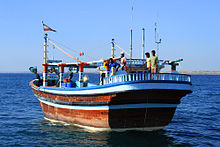Launch (boat)



A launch is an open motorboat.[1][2] The forward part of the launch’s deck may be covered. Prior to the era of engines on small craft, a launch was the largest boat carried on a sailing vessel, powered by sail or by oars. In competitive rowing, a launch is a motorized boat used by the coach during training.
History[]
The launch steadily replaced the long-boat in the Royal Navy over the latter half of the 18th century. Both were usually the biggest boat carried by a warship or a merchant vessel in the age of sail. Launches were preferred as having greater carrying capacity, though they could be considered less seaworthy. An important role for either was the carrying of drinking water. For example, a 33 foot launch of 1804 could carry 14 large "leaguers" (barrels containing 150 imperial gallons (680 l) each), making just over nine and half tonnes of water. A warship's launch would also be fitted with a windlass that allowed a ship's anchor to be carried or to be weighed (raised). A ship's boat would often be used to kedge a ship out of a harbour or away from a hazard before steam tugs were available to move sailing vessels.[3]: 41–43
The word "launch" comes from the Spanish lancha ("barge") and Portuguese, from Malay lancaran ("swift boat"), which in turn derived from lancar ("velocity without effort").[4]
In the age of sail, a ship carried a variety of boats of different sizes and uses. In addition to the launch, examples include the jolly boat, captain's gig, pinnace, and cutter. Distinctions among the smaller vessels were clear, both in design and purpose.[5] In the age of motorized ships these distinctions have largely disappeared, but the historic terms continue in use.
During the Demak Sultanate attack on Portuguese Malacca of 1513, lancaran were used as armed troop transports for landing alongside penjajap and kelulus, as the Javanese junks were too large to approach shore.[6]
In the 18th century, a launch was used to set the large anchors on a ship. The launch of that era had a square transom and was about 24 feet long. In 1788 Captain Bligh was set adrift in Bounty’s launch.
Civilian use in the UK[]
On the River Thames the term "launch" is used to mean any motorised pleasure boat. The usage arises from the legislation[7] governing the management of the Thames and laying down the categories of boats and the tolls for which they were liable.
Military launches in the UK[]
Motor Launch was the designation for a type of vessel used in World War II by the Royal Navy and some other navies[citation needed] for inshore work defending the coast from submarines. They were typically 60-to-115-foot or 18-to-35-metre long and carried relatively light armament – a few depth charges, a gun and a few machine guns.
Sports[]
In competitive rowing the term "launch" is used to refer to any motorized boat used by the coach to follow practicing boats during workouts.[citation needed]
See also[]
- RAF rescue launch
- Cabin cruiser
- Slipper launch
- Naphtha launch
- Picket boat, a naval launch
References[]
- ^ "Launch (3) noun". Merriam Webster. Retrieved October 29, 2014.
- ^ "Launch (2) noun". Oxford Dictionaries. Retrieved October 29, 2014.
- ^ May, W E; Stephens, Simon (1999). The Boats of Men of War (2003 publ Caxton Editions ed.). London: Chatham Publishing. ISBN 1-84067-4318.
- ^ Collins English Dictionary (Second ed.). London, Glasgow: Collins. 1986. p. 868. ISBN 0 00 433135-4.
- ^ Folkard, Henry Coleman (1863). The Sailing Boat: a Treatise On English And Foreign Boats, Descriptive of the Various Forms of Boats And Sails of Every Nation; With Practical Directions for Sailing, Management. London: Longman, Green, and Roberts.
- ^ Winstedt, Sir Richard (1962). A History of Malaya. Marican.
- ^ Thames Conservancy Act 1932
- Ship's boats
- Boat types
- Motorboats
- Ship type stubs